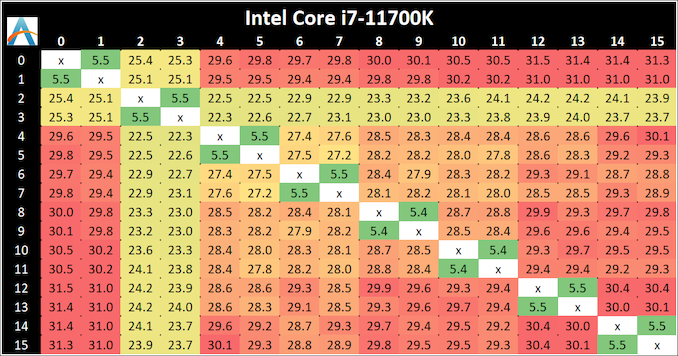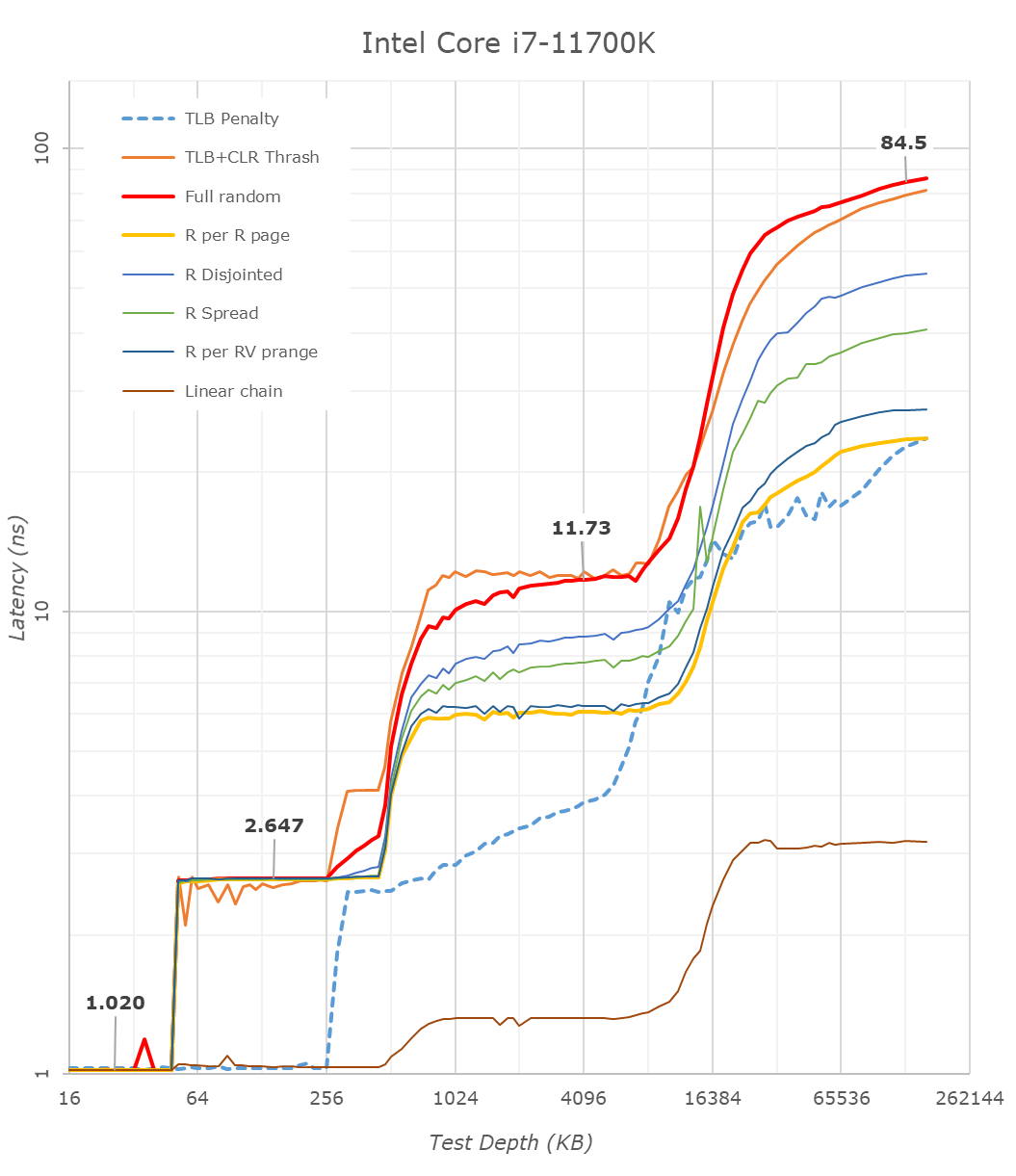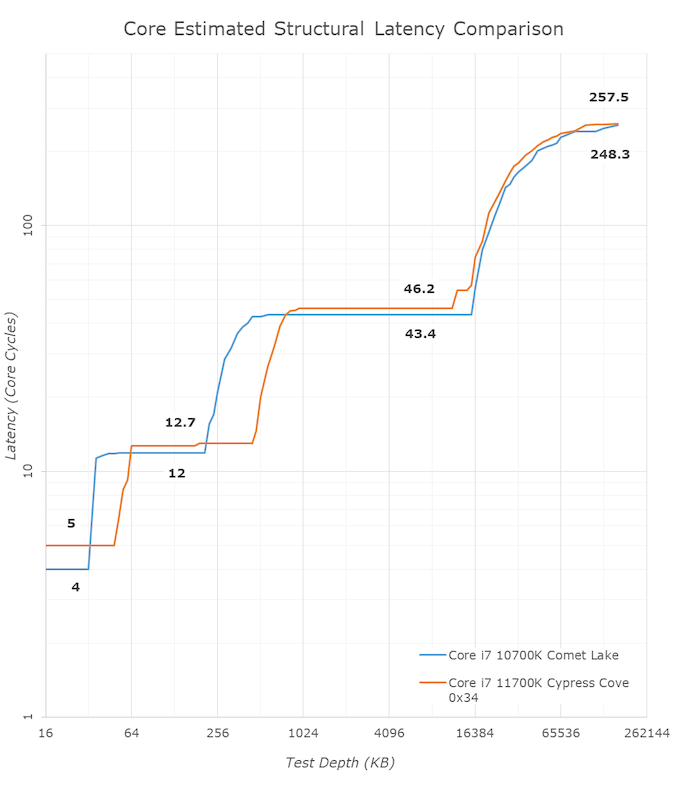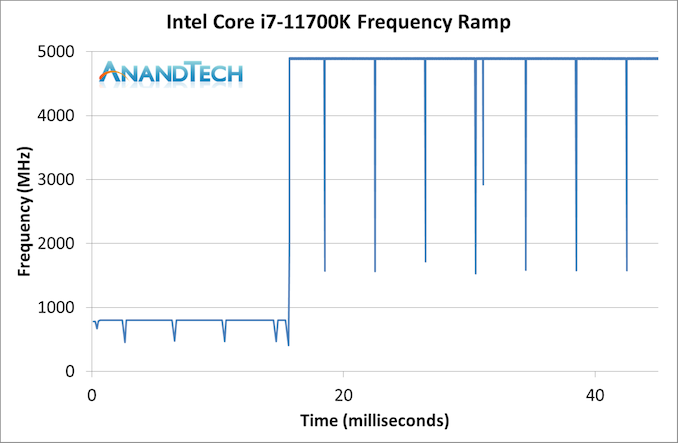Intel Core i7-11700K Review: Blasting Off with Rocket Lake
by Dr. Ian Cutress on March 5, 2021 4:30 PM EST- Posted in
- CPUs
- Intel
- 14nm
- Xe-LP
- Rocket Lake
- Cypress Cove
- i7-11700K
CPU Tests: Microbenchmarks
Core-to-Core Latency
As the core count of modern CPUs is growing, we are reaching a time when the time to access each core from a different core is no longer a constant. Even before the advent of heterogeneous SoC designs, processors built on large rings or meshes can have different latencies to access the nearest core compared to the furthest core. This rings true especially in multi-socket server environments.
But modern CPUs, even desktop and consumer CPUs, can have variable access latency to get to another core. For example, in the first generation Threadripper CPUs, we had four chips on the package, each with 8 threads, and each with a different core-to-core latency depending on if it was on-die or off-die. This gets more complex with products like Lakefield, which has two different communication buses depending on which core is talking to which.
If you are a regular reader of AnandTech’s CPU reviews, you will recognize our Core-to-Core latency test. It’s a great way to show exactly how groups of cores are laid out on the silicon. This is a custom in-house test built by Andrei, and we know there are competing tests out there, but we feel ours is the most accurate to how quick an access between two cores can happen.
The core-to-core numbers are interesting, being worse (higher) than the previous generation across the board. Here we are seeing, mostly, 28-30 nanoseconds, compared to 18-24 nanoseconds with the 10700K. This is part of the L3 latency regression, as shown in our next tests.
One pair of threads here are very fast to access all cores, some 5 ns faster than any others, which again makes the layout more puzzling.
Update 1: With microcode 0x34, we saw no update to the core-to-core latencies.
Cache-to-DRAM Latency
This is another in-house test built by Andrei, which showcases the access latency at all the points in the cache hierarchy for a single core. We start at 2 KiB, and probe the latency all the way through to 256 MB, which for most CPUs sits inside the DRAM (before you start saying 64-core TR has 256 MB of L3, it’s only 16 MB per core, so at 20 MB you are in DRAM).
Part of this test helps us understand the range of latencies for accessing a given level of cache, but also the transition between the cache levels gives insight into how different parts of the cache microarchitecture work, such as TLBs. As CPU microarchitects look at interesting and novel ways to design caches upon caches inside caches, this basic test proves to be very valuable.
Looking at the rough graph of the 11700K and the general boundaries of the cache hierarchies, we again see the changes of the microarchitecture that had first debuted in Intel’s Sunny Cove cores, such as the move from an L1D cache from 32KB to 48KB, as well as the doubling of the L2 cache from 256KB to 512KB.
The L3 cache on these parts look to be unchanged from a capacity perspective, featuring the same 16MB which is shared amongst the 8 cores of the chip.
On the DRAM side of things, we’re not seeing much change, albeit there is a small 2.1ns generational regression at the full random 128MB measurement point. We’re using identical RAM sticks at the same timings between the measurements here.
It’s to be noted that these slight regressions are also found across the cache hierarchies, with the new CPU, although it’s clocked slightly higher here, shows worse absolute latency than its predecessor, it’s also to be noted that AMD’s newest Zen3 based designs showcase also lower latency across the board.
With the new graph of the Core i7-11700K with microcode 0x34, the same cache structures are observed, however we are seeing better performance with L3.
The L1 cache structure is the same, and the L2 is of a similar latency. In our previous test, the L3 latency was 50.9 cycles, but with the new microcode is now at 45.1 cycles, and is now more in line with the L3 cache on Comet Lake.
Out at DRAM, our 128 MB point reduced from 82.4 nanoseconds to 72.8 nanoseconds, which is a 12% reduction, but not the +40% reduction that other media outlets are reporting as we feel our tools are more accurate. Similarly, for DRAM bandwidth, we are seeing a +12% memory bandwidth increase between 0x2C and 0x34, not the +50% bandwidth others are claiming. (BIOS 0x1B however, was significantly lower than this, resulting in a +50% bandwidth increase from 0x1B to 0x34.)
In the previous edition of our article, we questioned the previous L3 cycle being a larger than estimated regression. With the updated microcode, the smaller difference is still a regression, but more in line with our expectations. We are waiting to hear back from Intel what differences in the microcode encouraged this change.
Frequency Ramping
Both AMD and Intel over the past few years have introduced features to their processors that speed up the time from when a CPU moves from idle into a high powered state. The effect of this means that users can get peak performance quicker, but the biggest knock-on effect for this is with battery life in mobile devices, especially if a system can turbo up quick and turbo down quick, ensuring that it stays in the lowest and most efficient power state for as long as possible.
Intel’s technology is called SpeedShift, although SpeedShift was not enabled until Skylake.
One of the issues though with this technology is that sometimes the adjustments in frequency can be so fast, software cannot detect them. If the frequency is changing on the order of microseconds, but your software is only probing frequency in milliseconds (or seconds), then quick changes will be missed. Not only that, as an observer probing the frequency, you could be affecting the actual turbo performance. When the CPU is changing frequency, it essentially has to pause all compute while it aligns the frequency rate of the whole core.
We wrote an extensive review analysis piece on this, called ‘Reaching for Turbo: Aligning Perception with AMD’s Frequency Metrics’, due to an issue where users were not observing the peak turbo speeds for AMD’s processors.
We got around the issue by making the frequency probing the workload causing the turbo. The software is able to detect frequency adjustments on a microsecond scale, so we can see how well a system can get to those boost frequencies. Our Frequency Ramp tool has already been in use in a number of reviews.
Our ramp test shows a jump straight from 800 MHz up to 4900 MHz in around 17 milliseconds, or a frame at 60 Hz.














541 Comments
View All Comments
Hifihedgehog - Saturday, March 6, 2021 - link
They have to do an annual refresh or release to appeal to their investors. That's literally it. Honestly, Skylake+++++++++++++++ would have been a better choice because at least it would have better gaming performance than this hot mess. Now, you have idiots like Usman Pirzada at fake news WCCTech playing arm-chair apologist, saying that the peak power here is a lie since it is AVX-512 and other garbage. Well, newsflash: AVX-512 is one of a few reasons why Intel got improvements in IPC, so if you want an AVX2 to AVX2 load test, also test the 11700K with AVX-512 disabled. Intel loses some of their minor gains in synthetic benchmarks, where they are still losing to the Ryzen 5000.GeoffreyA - Sunday, March 7, 2021 - link
Leaving aside the 14 nm handicap, I reckon that Intel's engineers took Sunny Cove a bit too far, widening the out-of-order window excessively, adding more decoders, etc. One will notice that Zen 3, while raising performance considerably, was pretty conservative in its design.Hifihedgehog - Monday, March 8, 2021 - link
The reason here is the 14nm handicap. You cannot bring long lengths of transistor networks without having to counteract latency, noise, and a host of other problems that come from stretching a microarchitecture intended for shorter physical paths. As an extreme example, that is why Zen 3 will never be backported to a 1 micron process. ;)GeoffreyA - Monday, March 8, 2021 - link
Would be interesting to see Sunny Cove fabricated on TSMC's 7 nm. I always wanted to see such a comparison, with Zen 3, taking the process out of the picture.jayjr1105 - Saturday, March 6, 2021 - link
Intel apologists out in full force. What a joke. I can't believe I invested in the stock of Intel recently thinking they would turn it around. Can't wait for the GPU dept to underwhelm next.Makste - Saturday, March 6, 2021 - link
Tech journalism at its peak. It is in such a way that even a tech illiterate can easily understand what is being explained. Thanks for the effort Ian and Anandtech.I previously had categorized RL as mostly optimised for gaming. But now even with the peak power draw when using AVX 512 instructions leaves me without an immediate use recommendation.
outsideloop - Saturday, March 6, 2021 - link
Intel has been forced to release a Bulldozer. All AMD and TSMC need to do now is steadily increase supply in 2021. If Alder Lake is anything less than stupendous, Intel is (insert negative term).outsideloop - Saturday, March 6, 2021 - link
I don't know if you realize this Ian, but your article may have contributed to stabilizing AMD stock yesterday. There had been so much "Intel is returning to dominance!" gobletygook in the world investment community, and this article will do a lot to bring everyone back to earth and the reality of AMD technological and product superiority (for at least 2021).Ryan Smith - Saturday, March 6, 2021 - link
"your article may have contributed to stabilizing AMD stock yesterday. "Although we'd like to take credit for it, this seems unlikely. We didn't publish the article until after the market had closed for the day.
eva02langley - Monday, March 8, 2021 - link
Absolutely not, there is absolutely no connection with the stock price of AMD and this review. The stock stabilized because AMD stock value is undervalued at 75$. The real stock price should be closer to 105$, but the selloff of semiconductors companies last week was general. It happens because some people think the economy is going to restart the good old ways with vaccination... they are all wrong.